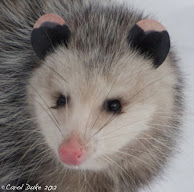 |
| WINTER |
In the last two posts of Seasonal Musings, I have shared bits of the North and South gardens. Today I take you more East, just behind the old farmhouse and little studio. I like to call this my stick garden, for through late fall and winter the branchlets of the small trees and shrubs stand naked, slender and twiggy. When snowfall dresses them in pure white frocks, their lovely forms are once again revealed. This is a great example of where an introduction of evergreen shrubs would be helpful.
You will recall Flower Hill Farm's stately elders . . . the immense Rock Maples from the last overview. The following images will show the north facades, of the one that lost a huge limb to an ice storm. This one stands most easterly on the top of the hill next to the house and offers an expansive vista to the many birds, who perch on any of its hundreds of branches and limbs.
 |
| Immature Red-tailed Hawk |
Raptors particularly enjoy the view of the gardens and fields from this height. I am thrilled to see these beautiful creatures and appreciate their helping me control the populations of voles, mice and rabbits.
 |
| SPRING |
Every Spring seems miraculous, when sticks sigh . . . spilling buds and hues of greens. As our days grow longer, Spring light awakens the gardens and forests. The hillsides become alive in color much like a mini Autumn.
Lilacs, Beautybush, Elderberry, Weeping Crabapple and Viburnum breathe out their meticulously studious shapes. In order to keep an open view from the studio and barn, they must be pruned three times a year. You see, I planted the gardens before renovating the buildings. My first love here has always been the flowing flowering land, rolling hills and expanding skies.
 |
| FRENCH LILACS, BEAUTYBUSH, WEEPING CRABAPPLE |
 |
| Tiger Swallowtail sipping Beautybush |
 |
| Blooming Beautybush, Fading Viburnum and Late Pink and Korean Lilacs |
 |
| SUMMER |
As our planet journeys around the sun, daylight spreads out like a large long, flowing table cloth . . . Summer flies by. . . the garden swells and life abounds beneath the thickening canopies of darkening greens. Leaves fully unfurl concealing hidden nests belonging to a diverse community of songbirds. The east branch of the Mill River runs at the bottom of this hillside, creating lovely soft streams and drifts of fog and mist, climbing then covering the landscape and gardens throughout the year.
 |
| Northern Harrier |
Above it all watchful eyes fly by too.
 |
| AUTUMN |
As late Summer turns towards Autumn, an excitement of color and light fills each and every day.
Moist misty moods have their way with us and stimulate the tingling nerve endings of our imaginations.
There are large and small miracles to be seen or found. I gasp whenever I see a wondrous rainbow!
The view of the Nonotuck peak of Mount Tom plays an important role in the beauty of Flower Hill Farm . . . every day . . . of every season. In the Autumn, atmospheric blues complement the bright oranges in the landscape, as the stronger green of chlorophyll fades, revealing the carotenoids that were dwelling side by side all Spring and Summer. The carotenoids create colors of oranges, yellows and browns. Those reds and crimsons seen in the distance are made by anthocyanins that are only produced in the Autumn under certain weather conditions. Anthocyanins also give us the reds in apples ripening on trees.
Mount Tom Range is divided from the Mount Holyoke Range by the Connecticut River, which creates thick blankets of fog along the base, giving this blessed viewer countless images that hourly and daily change.
When the Rock Maple finally puts on its show . . . it is astounding.
Near full circle into November . . . the gardens inhale deep into the earth and await Winters return. Late Autumn has a special light and magic of its own. The muted colors in the garden are somewhat calming . . . reminding the gardener of the approaching quiet time to pull inside, regroup and dream of recurring Spring.



































































































































